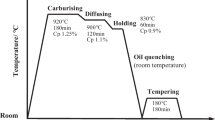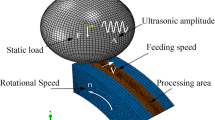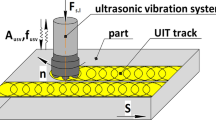Abstract
To improve the anti-fatigue performance and the service life of parts made of 7050 aluminium alloy, the surface integrity of the workpiece treated by two-dimensional ultrasonic surface rolling (TDUSR) was comprehensively evaluated, and the optimization methods of the process parameters were proposed in this paper. The orthogonal experimental method was used to design an experiment program for TDUSR 7050 aluminium alloy. Based on the experimental results, the entropy weight method was used to make objectively weight for each quantifiable evaluation index. The technique for order preference by similarity to an ideal solution (TOPSIS) improved by the grey relational analysis (GRA) was presented to evaluate the surface integrity. Quadratic regression analysis was applied to establish prediction models for the surface roughness, microhardness, residual stress and the close degree. The optimal process parameters for the surface integrity were obtained using planning solution based on the prediction models. The results show that the static load and the feed rate have significant effects on the surface integrity, and their contributions are 60.52% and 28.05%, respectively. The maximal close degree obtained by planning solution is bigger than that obtained by TOPSIS improved by GRA. The validation test result proves that the overall evaluation method of TOPSIS improved by GRA combined with prediction modelling method by quadratic regression analysis can provide comparatively better process parameters and obtain more desirable process responses.



Similar content being viewed by others
References
Molent L (2015) A review of equivalent pre-crack sizes in aluminium alloy 7050–T7451. Fatigue Fract Eng Mater Struct 37(10):1055–1074
Mari A et al (2017) Fatigue strength evaluation of small defect at stress concentration. Procedia Struct Integr 7:351–358
Gallagher JP, Molent L (2015) The equivalence of EPS and EIFS based on the same crack growth life data. Int J Fatigue 80:162–170
Thakur A et al (2016) State-of-the-art in surface integrity in machining of nickel-based super alloys. Int J Mach Tool Manuf 100:25–54
Maximov JT et al (2016) Influence of the process parameters on the surface roughness, micro-hardness, and residual stresses in slide burnishing of high-strength aluminum alloys. J Braz Soc Mech. Sci Eng 39:3067–3078
Liu C, Liu D et al (2017) Effect of the ultrasonic surface rolling process on the fretting fatigue behavior of Ti-6Al-4V alloy. Materials 10(7):833–844
Zhang Q et al (2017) Microstructure and surface properties of 17-4PH stainless steel by ultrasonic surface rolling technology. Surf Coat Technol 321:64–73
Sattari S, Atrian A (2017) Effects of the deep rolling process on the surface roughness and properties of an Al-3vol%SiC nanoparticle nanocomposite fabricated by mechanical milling and hot extrusion. Int J Miner Metall Mater 24(7):90–101
Amanov A, Cho IS, Pyun YS (2016) Microstructural evolution and surface properties of nanostructured Cu-based alloy by ultrasonic nanocrystalline surface modification technique. Appl Surf Sci 388:185–195
Lu LX, Sun J et al (2016) Study on surface characteristics of 7050-T7451 aluminum alloy by ultrasonic surface rolling process. Int J Adv Manuf Technol 87(9–12):2533–2539
Xu XC, Liu DX (2019) Influence of ultrasonic rolling on surface integrity and corrosion fatigue behavior of 7B50-T7751 aluminum alloy. Int J Fatigue 125:237–248
Gavrilova TM (2008) Contact friction in the deformation zone during ultrasonic surface plastic deformation. Russ Eng Res 28(8):764–768
Zheng JX, Luo AM (2015) Experimental study on aluminum alloy 6061-T6 by ultrasonic deep rolling with longitudinal-torsional vibration. Rare Met Mater Eng 44(3):733–737
Li L, Kim M, Lee S et al (2018) Study on surface modification of aluminum 6061 by multiple ultrasonic impact treatments. Int J Adv Manuf Technol 96(1):1–10
Li G, Qu SG, Pan YX et al (2016) Effects of the different frequencies and loads of ultrasonic surface rolling on surface mechanical properties and fretting wear resistance of HIP Ti–6Al–4V alloy. Appl Surf Sci 389:324–334
Yoon K, Hwang CL (1985) Manufacturing plant location analysis by multiple attribute decision making: part II multi-plant strategy and plant relocation. Int J Prod Res 23(2):361–370
Nguyen H, Pham V, Ngo N (2018) Application of TOPSIS to Taguchi method for multi-characteristic optimization of electrical discharge machining with titanium powder mixed into dielectric fluid. Int J Adv Manuf Technol 98:1179–1198
Deng JL (1982) Control problems of grey systems. Syst Control Lett 1(5):288–294
Dinesh Kumar R et al (2019) Single and multi-response optimization and validation of mechanical properties in dissimilar friction stir welded AA2219-T87 and AA7075-T73 alloys using T-GRA. Exp Tech 43:245–259
Reddy PV et al (2020) Simultaneous optimization of drilling responses using GRA on Al-6063/TiC composite. SN Appl Sci 2:431
Yuvaraj N, Kumar MP (2015) Multiresponse optimization of abrasive water jet cutting process parameters using TOPSIS approach. Mater Manuf Process 30(7):882–889
Senapati NP et al (2017) Multi-objective optimization of EDM process parameters using PCA and TOPSIS method during the machining of Al-20% SiCp metal matrix composite. In: Innov des dev pract aerosp autom eng, pp 359–367
Kabnure BB et al (2018) Optimization to develop multiple response microstructure and hardness of ductile iron casting by using GRA. J Inst Eng India Ser 99:235–243
Wu XD, Li WM, Zhang L (2012) Evaluation for the hypersonic near-space target threat based on GRA-TOPSIS model. Adv Mater Res 532–533:1046–1050
Nyaoga R et al (2016) Application of Grey-TOPSIS approach to evaluate value chain performance of tea processing chains. Decis Sci Lett 5:431–446
Celik E et al (2016) An extended fuzzy TOPSIS-GRA method based on different separation measures for green logistics service provider selection. Int J Environ Sci Technol 13:1377–1392
Sari T et al (2016) Supplier selection with grey relational analysis. Int J Emerg Res Manag Technol 5(4):61–70
Choi Y (2015) Influence of feed rate on surface integrity and fatigue performance of machined surfaces. Int J Fatigue 78:46–52
Das S et al (2010) Effect of the rolling speed on microstructural and mechanical properties of aluminum–magnesium alloys prepared by twin roll casting. Mater Des 31(3):1633–1638
Liu M, Li JY, Ma Y et al (2016) Surface nanocrystallization and property of Ti6Al4V alloy induced by high pressure surface rolling. Surf Coat Technol 289:94–100
Wang YZ, Zhao J, Wang Y et al (2017) Multi-objective optimization and grey relational analysis on configurations of organic Rankine cycle. Appl Therm Eng 114:1355–1363
Zheng JX, Liu WC, Duan YT (2017) Interaction effects of process parameters on surface quality of two-dimensional ultrasonically extruded 7075 aluminum alloy. Acta Armamentarii 38(6):1231–1238
Acknowledgements
This work was supported by the National Natural Science Foundation of China (Grant Numbers 51005071, 51575163) and the Key Research and Development and Promotion Program in Henan Province, China (Grant Number 202102210062).
Author information
Authors and Affiliations
Corresponding author
Additional information
Technical Editor: Lincoln Cardoso Brandao.
Publisher's Note
Springer Nature remains neutral with regard to jurisdictional claims in published maps and institutional affiliations.
Rights and permissions
About this article
Cite this article
Zheng, J., Zhu, L., Liu, H. et al. Overall evaluation of the surface integrity in two-dimensional ultrasonic surface rolling 7050 Al alloy. J Braz. Soc. Mech. Sci. Eng. 42, 325 (2020). https://doi.org/10.1007/s40430-020-02423-1
Received:
Accepted:
Published:
DOI: https://doi.org/10.1007/s40430-020-02423-1




